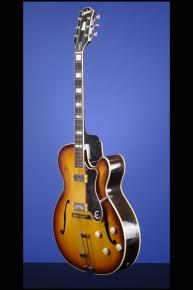Near Mint Epiphone Equivalent of the Gibson ES-350.
1958 Epiphone Broadway E252.
This super lightweight 3 1/3 inch thick guitar weighs 7.20 lbs. and has a nice, fat nut width of just over 1 11/16 inches and a scale length of 25 1/2 inches. Triple-bound laminated maple body. Three-piece mahogany / maple / mahogany neck with a wonderful medium to thick deep "V" profile. Brazilian rosewood fretboard with 20 original medium jumbo frets and inlaid pearl block position markers. Headstock with inlaid pearl "Epiphone" script logo and pearl column inlay. Black metal truss-rod cover with three screws. Individual Kluson Deluxe tuners with single-ring Keystone plastic buttons and "D-169400 / Patent No" stamped on the underside. Two New York pickups with cream plastic bases and outputs of 6.36k and 5.88k. Single-layer tortoiseshell pickguard with single white binding and silver Epiphone stylized "E" logo. Four controls (two volume, two tone) on lower treble bout plus three-way selector switch on upper bass bout. Epiphone octagonal white Bakelite "carrosel" knobs. Rosewood bridge with pre-set compensating saddle and Epiphone Frequensator tailpiece. The original tuner buttons have shrunken but are still sound and operable (easily replaceable with Uncle Lou Premium Tips). Apart from a minuscule amount of belt buckle marking on the back, one tiny mark on the top, and the usual minor finish checking, this guitar is in near mint (9.25) condition. Housed in the original Epiphone brown hardshell case with purple plush lining (9.25).
"New York" style pickups are the most common New York-era Epiphone pickup. They are also considered the "best" top-of-the-line pickup model for pre-1962 Epiphones.
The Epiphone 'Frequensator tailpiece' was featured on high-end models between 1939 and 1970 and allowed for a longer string length on the 3 bass strings and a shorter string length on the 3 treble strings. The two parts are sometimes reversed by players to accommodate short strings.
After Gibson took over Epiphone in May 1957, they began producing several new guitars, and the Epiphone line of the early 1960s included some models that rivaled, or even surpassed anything in the Gibson range, in price as well as in appeal. Epiphone had used the "Broadway" name from 1931-1958 on their non-cutaway acoustic archtop, but from 1958 to 1970 the "Broadway" designation was transferred to this new full-size electric archtop, first with New York pickups, and then from 1961 with mini-humbuckers. This guitar (Epiphone's version of the third variant Gibson ES-350 which was discontinued in 1956) is typical of Epiphone's late 1950s excellence.
"The revived Epiphone line of 1958 used the familiar guitars of earlier years as a starting point... However, the image of the old Epiphone company disappeared quickly when it came to the electric archtops... The Broadway, which had never been available as an electric in the old Epi line, was now available only as an electric in the Gibson-made offering, and it was the only electric with a full-depth hollow body" (Walter Carter, Epiphone: The Complete History, pp. 58-59).








